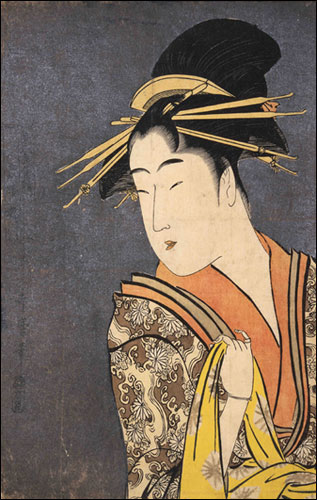
Kitagawa Utamaro (1753-1806). Takigawa, a courtesan
from the Gomeiro house. Circa 1794-1795. Inv. 219 |
|
MUSÉES D'EXTRÊME-ORIENT
Tour japonaise, Pavillon chinois,
Musée d’Art japonais
Avenue Van Praet 44
B - 1020 Bruxelles
INFORMATION:
Tel. 02 268 16 08. Fax. 02 268 16 50
Email : info@mrah.be
Site : www.mrah.be
HOURS:
Tuesday to Friday, from 9:30 AM to 5:00 PM,
Saturday, Sunday and holiday from 10:00 AM to 5:00 PM
Closed on Monday and 01/01, 01/11, 11/11 et 25/12
Cash desks closed at 4:30 PM
ADMISSION FEES:
Full rate: 3€
Concessions : 2€ -1€
PRESS CONTACT:
Bart Suys
Tel.: 02 741 73 00
Email: b.suys@kmkg.be

|
As of 22 March, Brussels will host a new museum, the Musée d’Art japonais (Museum of Japanese Art). It will set up in a building built in the beginning of the XXth century, near the Japanese Tower and behind the Chinese Pavilion, of which in the beginning it was to be an annex, the garage and stable. The Musées royaux d’Art et d’Histoire (Royal Museums of Art and History) have decided to renovate this abandoned outbuilding, whose access was forbidden for a long time to the public, to present their collections of classical Japanese art in them.
The museums of the Far East
The exceptional, exotic ensemble in Laeken that includes the Japanese Tower - inaugurated in 1905 – and the Chinese Pavilion and its outbuildings – completed in 1910 - is one of the last major architectural projects of King Léopold II. The only oriental thing about the buildings is their external aspect. The architect, Alexandre Marcel (1860-1928), was French, the materials Belgian, and the decors are creations of Parisian artists. But the buildings were given an external cover made in the Far East in order to have a touch of authenticity. The ornaments on the Japanese Tower come from Yokohama, and the porch – designed for the Paris Universal and International Exhibition in 1900 – was commissioned from Tokyo. In the Chinese sector, the polychrome woodwork of the kiosk and the main building were done in Shanghai
Europe and Asia
These buildings are the proof of the economic-cultural relations that started in the XIXth century between Europe and the Far East. Their permanent collections play the same role. These are objects made purposely for export. The Japanese Tower presents decorative porcelains made for Europe between the middle of the XVIIth century and that of the XVIIIth century, as well as articles of Japanese decorative art, greatly admired at the Universal exhibitions, during the second half of the XIXth century and the beginning of the XXth century. As for the Chinese Pavilion, it holds important collections that include the whole range of Chinese porcelain produced for Europe, during the XVIIth and XVIIIth centuries, and shipped through the Compagnies des Indes.
The collections of the new museum
The new Museum of Japanese art hosts the collections of classical Japanese art kept by the Musées royaux d’art et d’histoire (Royal Museums of Art and History), which concentrated on the Edo period (1600-1868). The nearly 12.000 pieces of this important patrimony will never all be exposed at the same time. The policy is to create significant ensembles from this important fund, to present them permanently, but through regular rotation, given the frailness of the works. The choices thus made demonstrate the Japanese know-how, acquired in particular in the arts of metal, lacquer, painting, xylography, textile, ceramics and sculpture. .
Illustration: The new Museum of Japanese Art
From Wednesday 22 to Sunday 26 March, admission to the new Museum of Japanese Art will be free of charge, and various activities will be presented to the public, including kendo, ikebana, origami, as well as guided tours and stories for children.
|